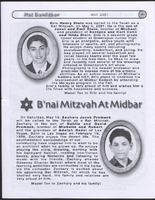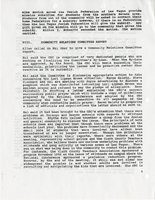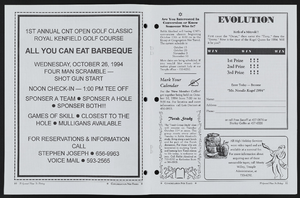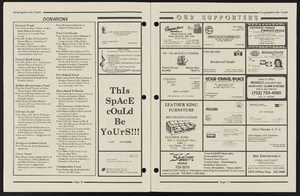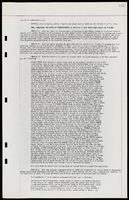Search the Special Collections and Archives Portal
Search Results
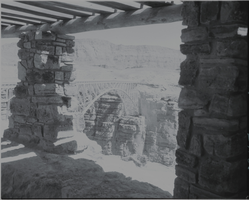
Film transparency of of the Navajo Bridge, Grand Canyon, Arizona, circa 1930s
Date
Archival Collection
Description
Image
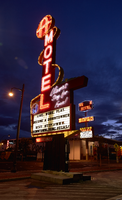
Photographs of The Ambassador Motel sign, Las Vegas (Nev.), April 28, 2016
Date
Archival Collection
Description
Site address: 9th St and Fremont St
Sign owner: Jackie Gaughan(ca.1952)
Sign details: Opened ca. 1940 by Joseph Mikulich but was called Ambassador Auto Court, Jackie Gaughan renamed it in 1952 as "Jackie Gaughan's Ambassador East". This location closed down in 1996 and was demolished 2007. Currently this location holds a parking lot, but the sign was restored in 2013 and put back in its original location.
Sign condition: 5- Was recently restored and is in great condition.
Sign form: Pylon
Sign-specific description: The building has been demolished, the sign has been restored and put on Fremont street. It is large red signage with a googie style "A" on top that looks like an arch. Vertically are the letters " MOTEL" in red neon. In a ribbon fashion around the letters are chasing incandescent light bulbs. In smaller white letters used to say "Ambassador Motel East" but now it states "Llamas stay for free" in a cursive white neon font. Beneath the letters is a reader board.
Sign - type of display: Neon, Incandescents and backlit reader board.
Sign - media: Steel and plastic
Sign - non-neon treatments: Reader board and Incandescents.
Sign animation: Chasing
Notes: incandescent light bulbs.
Sign environment: This is located East side of Fremont Street across the street from Atomic Liquors.
Sign - date of installation: Circa 1950
Sign - date of redesign/move: 2013 Restoration
Sign - thematic influences: This sign has been a part of the recent trend to restore old signs on Fremont Street to keep the downtown neon culture alive.
Sign - artistic significance: This sign has a retro 50's/ 60's motel sign trend to it.
Survey - research locations: Las Vegas Sun Article -https://lasvegassun.com/news/2013/jun/21/joe-downtown-motel-long-gone-ambassador-sign-being/ Classic Vegas website -http://classiclasvegas.squarespace.com/classic-las-vegas-blog/2007/12/19/the-ambassador-east.html Vintage Las Vegas Website -http://vintagelasvegas.com/search/Ambassador+Motel+
Surveyor: Wyatt Currie-Diamond
Survey - date completed: 2017-09-17
Sign keywords: Pylon; Neon; Incandescent; Backlit; Chasing; Steel; Plastic; Reader board; Back to back
Mixed Content
Hope Anstett oral history interview
Identifier
Abstract
Oral history interview with Hope Anstett conducted by Claytee D. White on December 8, 2003 for the Boyer Early Las Vegas Oral History Project. In this interview, Anstett talks about moving to Las Vegas, Nevada in 1939 with her mother and brother after a doctor recommended a move to a drier climate. Her mother rented a home from Senator Key Pittman and opened a photograph studio and dress shop in the front, with the family living in the back. She describes what it was like growing up in a small community, the schools she attended, the Las Vegas High School Rhythmettes drill team, and the activities available including Helldorado Days and the local recreation center. Later she discusses what the city was like during the war years, the family's move to Oregon, graduating from college, and getting married. She explains that she moved back to Las Vegas while her husband was deployed with the military and worked until his return and the birth of their first child. She also talks about her civic activities, her husband's career with Silver State Disposal, and their post-retirement travel and philanthropic work with the University of Nevada, Las Vegas (UNLV).
Archival Collection
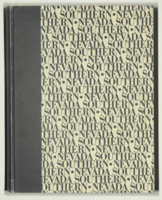
Epilogue: Nevada Southern University Yearbook, 1964
Date
Description
Yearbook main highlights: schools and departments; detailed lists with names and headshots of faculty, administration and students; variety of photos from activities, festivals, campus life, and buildings; campus organizations such as sororities, fraternities and councils; beauty contest winners; college sports and featured athletes; and printed advertisements of local businesses; Institution name: Nevada Southern University, Las Vegas, NV
Mixed Content
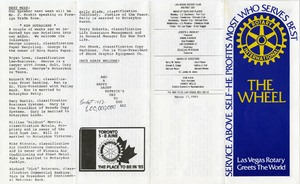
The Wheel Las Vegas Rotary Club newsletter, March 17, 1983
Date
Archival Collection
Description
Text

